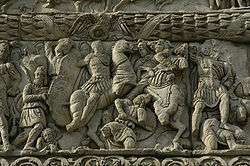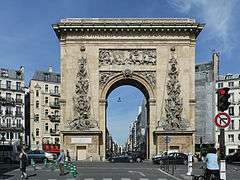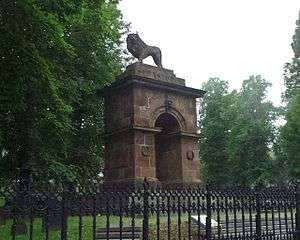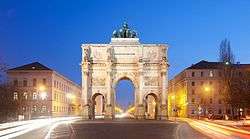A triumphal arch is a monumental structure in the shape of an archway with one or more arched passageways, often designed to span a road. In its simplest form a triumphal arch consists of two massive piers connected by an arch, crowned with a flat entablature or attic on which a statue might be mounted or which bears commemorative inscriptions. The main structure is often decorated with carvings, sculpted reliefs, and dedications. More elaborate triumphal arches may have multiple archways.
Triumphal arches are one of the most influential and distinctive types of architecture associated with ancient Rome. Thought to have been invented by the Romans, the triumphal arch was used to commemorate victorious generals or significant public events such as the founding of new colonies, the construction of a road or bridge, the death of a member of the imperial family or the accession of a new emperor.
The survival of great Roman triumphal arches such as the Arch of Titus inspired many post-Roman states and rulers, up to the present day, to erect their own arches in emulation of the Romans. Arches in the Roman style have been built in many cities around the world, most notably the Arc de Triomphe in Paris, the Narva Triumphal Arch in Saint Petersburg, the Wellington Arch in London, and India Gate in Delhi.
Triumphal arch is also the name given to the arch above the entrance to the chancel of a medieval church where a rood can be placed.[1]
Origins and development
Roman triumphal arches
The origins of the Roman triumphal arch are unclear.
The development of the triumphal arch is often associated with ancient Roman architecture. To fully understand this development however it is important to understand the importance of basic arches in Roman civilization. The Romans had learned how to construct effective arches from the Etruscans, who lived in central Italy.[2] This knowledge had a major impact on the architecture of Roman civilization. As a result, the Romans used arches for things such as aqueducts, amphitheaters, bridges, and domed temples.[2] They had effectively used the arch in various aspects of their civilization and city structure. Since the Romans had effectively perfected this architectural structure, one could conclude that the arch symbolized perfection and triumph in Roman society. Monumental gateways had already been in use for hundreds of years by civilizations such as the Hittites, Assyrians, Babylonians and Myceneans.[3]
There were precursors to the triumphal arch within the Roman world; in Italy, the Etruscans used elaborately decorated single bay arches as gates or portals to their cities. Surviving examples of Etruscan arches can still be seen at Perugia and Volterra.[4] The two key elements of the triumphal arch – a round-topped arch and a square entablature – had long been in use as separate architectural elements in ancient Greece. The Greeks made comparatively little or no use of the arch, confining it to structures such as tombs and sewers that were under external pressure, but made extensive use of entablatures in their temples. Entablatures were an essential part of the structural fabric of such buildings, as they were used to hold up the roofs. The great innovation of the Romans was to combine a round arch and a square entablature in a single free-standing structure. The columns became purely decorative elements on the outer face of arch, while the entablature, liberated from its role as a building support, became the frame for the civic and religious messages that the arch builders wished to convey.[5]
The first recorded Roman triumphal arches were set up in the time of the Roman Republic.[6] Generals who were granted a triumph were termed triumphators and would erect fornices or honorific arches bearing statues to commemorate their victories. A number of fornices were built in Rome during the Republican era. Lucius Steritinus erected two in 196 BC to commemorate his victories in Hispania. Another fornix was built on the Capitoline Hill by Scipio Africanus in 190 BC, and Quintus Fabius Maximus Allobrogicus constructed one in the Roman Forum in 121 BC.[7] None of them survive today and little is known about their appearance.[6]
Roman triumphal practices changed significantly at the start of the imperial period when the first Roman Emperor Augustus decreed that only emperors would be granted triumphs. The term fornix abruptly ceased to be used and was replaced by arcus, from which the English word "arch" is derived. Whereas Republican fornices were put up at the initiative and expense of the triumphator, without needing or requesting permission, imperial triumphal arches were erected for the triumphator by decree of the senate. The triumphal arch changed from being a personal monument to being an essentially propagandistic one, serving to announce and promote the presence of the ruler and the laws of the state.[4] Arches were not necessarily built as entrances, but – unlike many modern triumphal arches – they were often erected across roads and were intended to be passed through, not round.[3]
| Types of Roman triumphal arches |
|---|
| The Arch of Titus in Rome, an early Roman imperial triumphal arch with a single archway |
| The Porte Noire in Besançon, a single arch very ornate with superposition of two columns. |
|
Most Roman triumphal arches were built during the imperial period. By the fourth century AD there were 36 such arches in Rome, of which three have survived - the Arch of Titus (AD 81), the Arch of Septimius Severus (203-205) and the Arch of Constantine (312). Numerous arches were built elsewhere in the Roman Empire.[6] The single arch was the most common, but many triple arches were also built, of which the Triumphal Arch of Orange (circa AD 21) is the earliest surviving example. From the 2nd century AD, many examples of the arcus quadrifrons – a square triumphal arch erected over a crossroads, with arched openings on all four sides – were built, especially in North Africa. Arch-building in Rome and Italy diminished after the time of Trajan (AD 98-117) but remained widespread in the provinces during the 2nd and 3rd centuries AD; they were often erected to commemorate imperial visits.[7]
Little is known about how the Romans viewed triumphal arches. Pliny the Elder, writing in the first century AD, was the only ancient author to discuss them.[8] He wrote that they were intended to "elevate above the ordinary world" an image of an honoured person usually depicted in the form of a statue with a quadriga.[8] However, the designs of Roman imperial triumphal arches – which became increasingly elaborate over time and evolved a regularised set of features – were clearly intended to convey a number of messages to the spectator.
The ornamentation of an arch was intended to serve as a constant visual reminder of the triumph and triumphator. As such, it concentrated on factual imagery rather than allegory. The façade was ornamented with marble columns, and the piers and attics with decorative cornices. Sculpted panels depicted victories and achievements, the deeds of the triumphator, the captured weapons of the enemy or the triumphal procession itself. The spandrels usually depicted flying Victories, while the attic was often inscribed with a dedicatory inscription naming and praising the triumphator. The piers and internal passageways were also decorated with reliefs and free-standing sculptures. The vault was ornamented with coffers. Some triumphal arches were surmounted by a statue or a currus triumphalis, a group of statues depicting the emperor or general in a quadriga.[4][7] The inscriptions on Roman triumphal arches were works of art in themselves, with very finely cut, sometimes gilded letters. The form of each letter and the spacing between them was carefully designed for maximum clarity and simplicity, without any decorative flourishes, emphasizing the Roman taste for restraint and order. This conception of what later became the art of typography remains of fundamental importance down to the present day.[3]
| Ornamentation on Roman triumphal arches |
|---|
| Titus' triumphal procession depicted on the Arch of Titus, showing the loot captured from Jerusalem in 81 AD |
| Frieze on the Arch of Constantine, depicting Constantine I distributing gifts to the people |
|
Post-Roman triumphal arches
Roman triumphal arches remained a source of fascination well after the fall of Rome, serving as a reminder of past glories and a symbol of state power. At Lorsch Abbey, the triple-arched Torhalle was built in deliberate imitation of a Roman triumphal arch to signify continuity between the Carolingian Empire and its Roman predecessor. It was not until the coming of the Renaissance, however, that rulers sought to associate themselves systematically with the Roman legacy by building their own triumphal arches. One of the earliest was the "Aragonese Arch" at the Castel Nuovo in Naples, erected by Alfonso V of Aragon in 1443, although like the later Porta Capuana this was engaged as part of the entrance to the castle. By the end of the 16th century the triumphal arch had become closely linked with court theatre, state pageantry and military fortifications. The motif of the triumphal arch was also adapted and incorporated into the facades of public buildings such as city halls and churches.[9]
Temporary triumphal arches made of lath and plaster were often erected for royal entries. Unlike the individual arches erected for Roman conquerors, Renaissance rulers often built a row of arches through which processions were staged. They defined a space for the movement of people and denoted significant sites at which particular messages were conveyed at each stage. Newly elected popes, for instance, processed through the streets of Rome under temporary triumphal arches built specially for the occasion. Arches were also built for dynastic weddings; when Charles Emmanuel I, Duke of Savoy married Infanta Catherine Michelle of Spain in 1585, he processed under temporary triumphal arches that asserted the antiquity of the House of Savoy and associated his dynasty, through the art and architecture of the arches, with the imperial Roman past.[9]
Images of arches gained great importance as well. Although temporary arches were torn down after they had been used, they were recorded in great detail in engravings that were widely distributed and survived long after the original arches had been destroyed. The medium of engraving gave the viewer the opportunity to examine the allegories and inscriptions presented by the arches in a way that would not have been possible during the event.[9] Sometimes the arches depicted were not even real structures but existed entirely as imaginary representations of royal propaganda. One famous example was the Ehrenpforte Maximilians I by Albrecht Dürer, commissioned by the Emperor Maximilian I. It was one of the largest prints ever produced, measuring 3.75 metres (12.3 ft) high and consisting of 192 individual sheets, depicting an arch that was never intended to be built. It was printed in an edition of 700 copies and distributed to be coloured and pasted on the walls of city halls or the palaces of princes.[10]
The French led the way in building new permanent triumphal arches when the imperial ambitions of the Bourbon kings and Napoleon Bonaparte led to a spate of arch-building. By far the most famous arch from this period is the Arc de Triomphe in Paris, built from 1806–36, though it is consciously dissimilar from its Roman predecessors in omitting the customary ornamental columns – a lack that fundamentally changes the balance of the arch and gives it a distinctly "top-heavy" look.[9] Other French arches more closely imitated those of imperial Rome; the Arc de Triomphe du Carrousel in Paris, for instance, is closely modelled on the Arch of Septimius Severus in Rome.[11]
Triumphal arches have continued to be built into the modern era, often as statements of power and self-aggrandizement by dictators. Adolf Hitler planned to build the world's largest triumphal arch in Berlin. The arch would have been vastly larger than any previously built, standing 550 feet (170 m) wide, 92 feet (28 m) deep and 392 feet (119 m) – big enough for the Arc de Triomphe to fit into it 49 times. It was intended to be carved with the names of Germany's 1.8 million dead in the First World War. However, construction was never begun.[12] North Korea's dictator Kim Il Sung built the world's largest triumphal arch in Pyongyang in 1982.[7] It was designed to be substantially bigger than the Arc de Triomphe in Paris and was erected on the site where, on October 14, 1945, Kim Il Sung gave his first public speech to the North Korean people. It is decorated with sculptures and reliefs depicting "the triumphal returning of the victorious Great Leader to the country".[13]
The form of the triumphal arch has also been put to other purposes, notably the construction of monumental memorial arches and city gates such as the Brandenburg Gate in Berlin or the Washington Square Arch in New York City, or simple welcoming arches such as the Barcelona Triumphal Arch, built as an entrance to the fairgrounds for the 1888 World Fair. Although patterned after triumphal arches, these were built for quite different purposes - to memorialise war dead or to provide a monumental entrance to a city, as opposed to celebrating a military success or general.
| Post-Roman triumphal arches |
|---|
| The later Arcul de Triumf, inaugurated as a World War I memorial in 1936 in Bucharest, Romania, on the site of two earlier temporary structures |
| Siegestor in Munich, a Bavarian army monument, destroyed in World War II but partially rebuilt as a reminder for peace |
|
See also
References
- ↑ Curl, James Stevens (2006). Oxford Dictionary of Architecture and Landscape Architecture, 2nd ed., OUP, Oxford and New York, p. 658. ISBN 978-0-19-860678-9.
- 1 2 "Arches." Ancient Greece and Rome: An Encyclopedia for Students. Ed. Carroll Moulton. Vol. 1. New York: Charles Scribner's Sons, 1998. 45-46. World History in Context. Web. 1 Dec. 2013.
- 1 2 3 Honour, Hugh; Fleming, John (2005). A world history of art. Laurence King Publishing. ISBN 978-1-85669-451-3.
- 1 2 3 Zaho, Margaret Ann (2004). Imago triumphalis: the function and significance of triumphal imagery for Italian Renaissance rulers. Peter Lang. pp. 18–25. ISBN 978-0-8204-6235-6.
- ↑ Sullivan, George H. (2006). Not built in a day: exploring the architecture of Rome. Da Capo Press. pp. 133–134. ISBN 978-0-7867-1749-1.
- 1 2 3 "Triumphal arch." Encyclopædia Britannica (2010)
- 1 2 3 4 F. B. Sear and Richard John. "Triumphal arch." Grove Art Online. Oxford Art Online. 30 Jul. 2010
- 1 2 Ulrich Fürst; Stefan Grundmann (1998). The architecture of Rome: an architectural history in 400 presentations. Edition Axel Menges. p. 43. ISBN 978-3-930698-60-8.
- 1 2 3 4 Pollak, Martha (2010). Cities at War in Early Modern Europe. Cambridge University Press. pp. 244–265. ISBN 978-0-521-11344-1.
- ↑ Bartrum, Giulia (1995). German Renaissance Prints, 1490-1550. British Museum Press. ISBN 978-0-7141-2604-3.
- ↑ Rosenblum, Robert (1969). Transformations in late eighteenth century art. Princeton University Press. pp. 131–132. ISBN 978-0-691-00302-3.
- ↑ Zalampas, Sherree Owens (1990). Adolf Hitler: a psychological interpretation of his views on architecture, art, and music. Popular Press. p. 81. ISBN 978-0-87972-488-7.
- ↑ Lankov, Alexei (2007). North of the DMZ: essays on daily life in North Korea. McFarland. p. 83. ISBN 978-0-7864-2839-7.


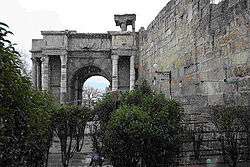

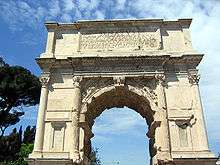
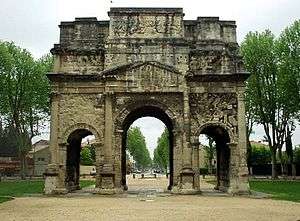


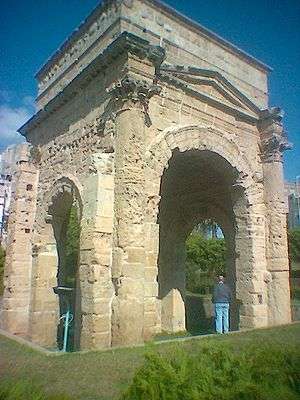
.jpg)


